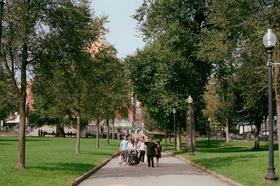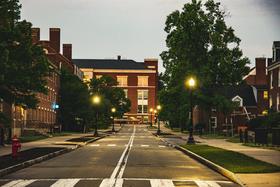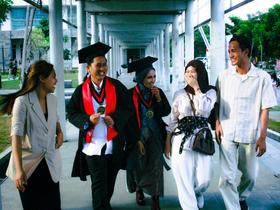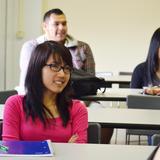- Kansas City Kansas Community College is a public, urban, open-door, and comprehensive community college committed to excellence in higher education. Through an accessible and supportive learning environment, the college mission is to provide higher education and lifelong learning to the varied communities, primarily in its service area of Wyandotte and Leavenworth counties.
School Highlights
Kansas City Kansas Community College serves 6,523 students (36% of students are full-time).
The college's student-teacher ratio of 12:1 is lower than the state community college average of 16:1.
Minority enrollment is 59% of the student body (majority Hispanic), which is more than the state average of 40%.
Quick Facts (2025-26)
- Enrollment: 6,523 students
- In-state tuition: $2,640
- Out-state tuition: $6,660
- Student-teacher ratio: 12:1
- Minority enrollment: 59%
- Source: Integrated Postsecondary Education Data System (IPEDS)
Top Rankings
Kansas City Kansas Community College ranks among the top 20% of public schools in Kansas for:
School Overview
The teacher population of 549 teachers has stayed relatively flat over five years.
Kansas City Kansas Community College
(KS) Community College Avg.
Carnegie Classification
Associate's Colleges: High Career & Technical-Mixed Traditional/Nontraditional
Associate's Colleges: Mixed Transfer/Career & Technical-High Nontraditional
Institution Level
Less than 2 yrs
At least 2 but less than 4 years
Institution Control
Public
Public
Total Faculty
549 staff
155 staff
School Calendar
Student Body
The student population of Kansas City Kansas Community College has grown by 8% over five years.
The student-teacher ratio of 12:1 has increased from 9:1 over five years.
The Kansas City Kansas Community College diversity score of 0.73 is more than the state average of 0.60. The school's diversity has stayed relatively flat over five years.
Total Enrollment
6,523 students
2,057 students
Student-Teacher Ratio
12:1
16:1
# Full-Time Students
2,367 students
606 students
# Part-Time Students
4,156 students
1,451 students
# Enrollment Undergraduate
652 students
229 students
# Full-Time Undergraduate Students
2,367 students
569 students
# Full-Time Graduate Students
n/a
11 students
# Part-Time Undergraduate Students
n/a
1,424 students
# Part-Time Graduate Students
n/a
5 students
Total Dormitory Capacity
n/a
342 students
% American Indian/Alaskan
n/a
1%
% Asian
4%
3%
% Hispanic
26%
15%
% Black
18%
8%
% White
41%
60%
% Hawaiian
n/a
1%
% Two or more races
5%
4%
% Non Resident races
1%
2%
% Unknown races
3%
6%
Diversity Score
0.73
0.60
College Completion Rate (Students who graduate in less than 4 years)
33%
41%
College Completion Rate (Students who graduate in 4 years or more than 4 years)
n/a
31%
Average Graduate Earnings (10 Years)
$33,400
$34,000
Tuition and Acceptance Rate
The public in-state tuition of $2,640 is less than the state average of $3,402. The in-state tuition has declined by 20% over four years.
The public out-state tuition of $6,660 is more than the state average of $4,296. The out-state tuition has stayed relatively flat over four years.
In-State Tuition Fees
$2,640
$3,402
Out-State Tuition Fees
$6,660
$4,296
Tuition Notes
$107 per credit hour for Wyandotte County residents, $119.50 for in-state, $231.50 for out-of-state
% Students Receiving Some Financial Aid
72%
90%
Median Debt for Graduates
$9,500
$8,892
Median Debt for Dropouts
$5,432
$5,467
Acceptance Rate
n/a
100%
ACT Composite
n/a
21
Source: 2024 (or latest year available) Integrated Postsecondary Education Data System (IPEDS)
School Notes
- Kansas City Kansas Community College seeks to provide an educational environment that encourages a strong commitment to high academic standards that sustains and advances excellence in learning and encourages challenging, innovative, and varied programs, teaching methods, and delivery systems; enhances student intellectual and social development to the fullest extent possible; and stresses the attitudes, behaviors, responsibilities, and skills required for effective learning and citizenship in a multicultural democracy. The college provides transfer education in the liberal arts and sciences, career education in a technical or professional field, general education and support services, continuing education and developmental education. The college provides community services that offer cultural and recreational activities, provide access to college facilities, and that serve as a planning, research, and resource center to the college's varied communities. The college seeks to provide a multicultural environment that reflects and respects diversity and seeks to increase understanding and appreciation of differences. A campus environment that promotes the teaching and learning process through accessible, comfortable, safe, and well-maintained facilities.
Frequently Asked Questions
How much does Kansas City Kansas Community College cost?
Kansas City Kansas Community College's tuition is approximately $2,640 for In-State students and $6,660 for Out-State students.
What is Kansas City Kansas Community College's ranking?
Kansas City Kansas Community College ranks among the top 20% of community college in Kansas for: Diversity in US community colleges and Largest student body.
In what neighborhood is Kansas City Kansas Community College located?
Kansas City Kansas Community College is located in the Victory Hills neighborhood of Kansas City, KS.
Recent Articles

Seamless Community College → University Transfer Guide 2025
Updated 2025 guide for parents & educators: navigating community college to university transfers with latest data, cost, policy insights and tips.

Is Your Community College Top Ranked? 2025 Insights
Understand what makes a top-ranked community college in 2025: cost, retention, rankings, and what to look for as a parent or educator.

Transfer Pathways 2025-26: Community College to 4-Year Success Guide
2025-26 update: essential transfer pathways, policy changes, data, and realistic tips for community college students aiming for 4-year universities.











